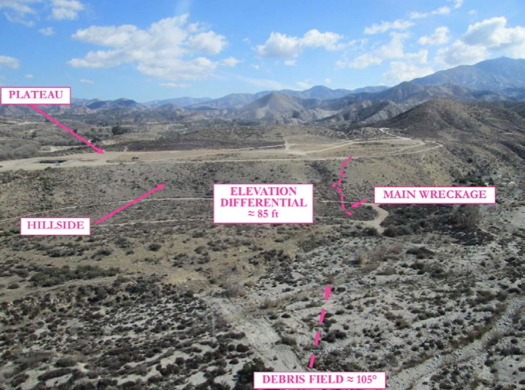
A diagram shows the location of the 2013 accident, which occurred on a movie ranch near Acton, Calif. NTSB Image
The U.S. National Transportation Safety Board (NTSB) has released its probable cause report for a 2013 helicopter crash that occurred during production of a reality television show, faulting the pilot for poor decision-making and a Federal Aviation Administration (FAA) inspector for inadequate oversight.
The Feb. 10, 2013, crash in Acton, Calif., occurred on a dark, moonless night during filming of a military-themed reality show for the Discovery Channel. Three people were killed in the accident: pilot David Gibbs, cameraman Darren Rydstrom, and castmember Michael Donatelli.
According to the NTSB report, the tentative script for the production shoot called for an airborne actor to drop a backpack to the ground while the helicopter — a Bell 206B JetRanger — was in a hover. Two flights were required to get the desired shots, involving two different actors at separate locations on a movie ranch.
Cameras in the helicopter captured audio and video recordings of both flights. During the first flight, which occurred around 9 p.m., Gibbs made numerous comments about his lack of visual cues and his inability to see the drop zone in the dark night conditions. He also remarked on the brightness of a flexible light pad affixed to the center windshield frame in the cockpit, used to illuminate the face of the actor in the left front seat.
Before the second flight, Rydstrom asked Gibbs if the light pad could be on; Gibbs responded, “We’ll see, it just really [sigh] blinds me.” Shortly before takeoff, Rydstrom instructed Donatelli on how to turn the light off. About a minute after takeoff, Gibbs interrupted Donatelli’s scripted dialogue to say, “I need to lose this light, this key light here.” Rydstrom acknowledged him and told Donatelli to turn off the light.
Eight seconds later, Rydstrom was recorded as saying, “Where did uh, we’re going down low” — indicating that he was temporarily disoriented and then noted that they were descending, according to the NTSB’s analysis. Donatelli cycled through the light’s settings and eventually turned it off while Gibbs simultaneously stated, “Okay, okay, I can’t.” The last words recorded were Rydstrom saying “Pull up, pull up” a second before the helicopter impacted terrain.
After finding no evidence of mechanical malfunctions or anomalies that would have precluded normal operation, NTSB investigators concluded that Gibbs was likely temporarily blinded by the light and lost visual reference to the ground, resulting in controlled flight into terrain.
“The pilot recognized on the first flight that he was operating with reduced/no visibility and with a bright light in the cockpit that ‘blinded’ him when it was on but chose to proceed with both flights likely because he believed that was what was required to fulfill the production requirements,” the report states. “As the pilot, he was responsible for the safe operation of the helicopter and should have initiated the measures necessary to ensure that the helicopter’s internal lighting and the lighting on the ground would enable him to conduct the flight in a safe manner.”
The NTSB also criticized the FAA inspector who approved the Motion Picture Plan of Activities (POA) for the production. According to the report, “The FAA inspector had an opportunity to examine the proposed flight and location and determine if the proposed flight activities would be safe, but he failed to identify that the flight would be conducted on a moonless night over terrain with limited ground features and lights and to assess whether the equipment that would be used for lighting and filming would enable the pilot to conduct the flight in a safe manner. It is likely that, if the inspector had been fully aware of the conditions of the intended operation, he might have identified that the proposed flight activities were potentially unsafe.”
The full report can be found on the NTSB website.









